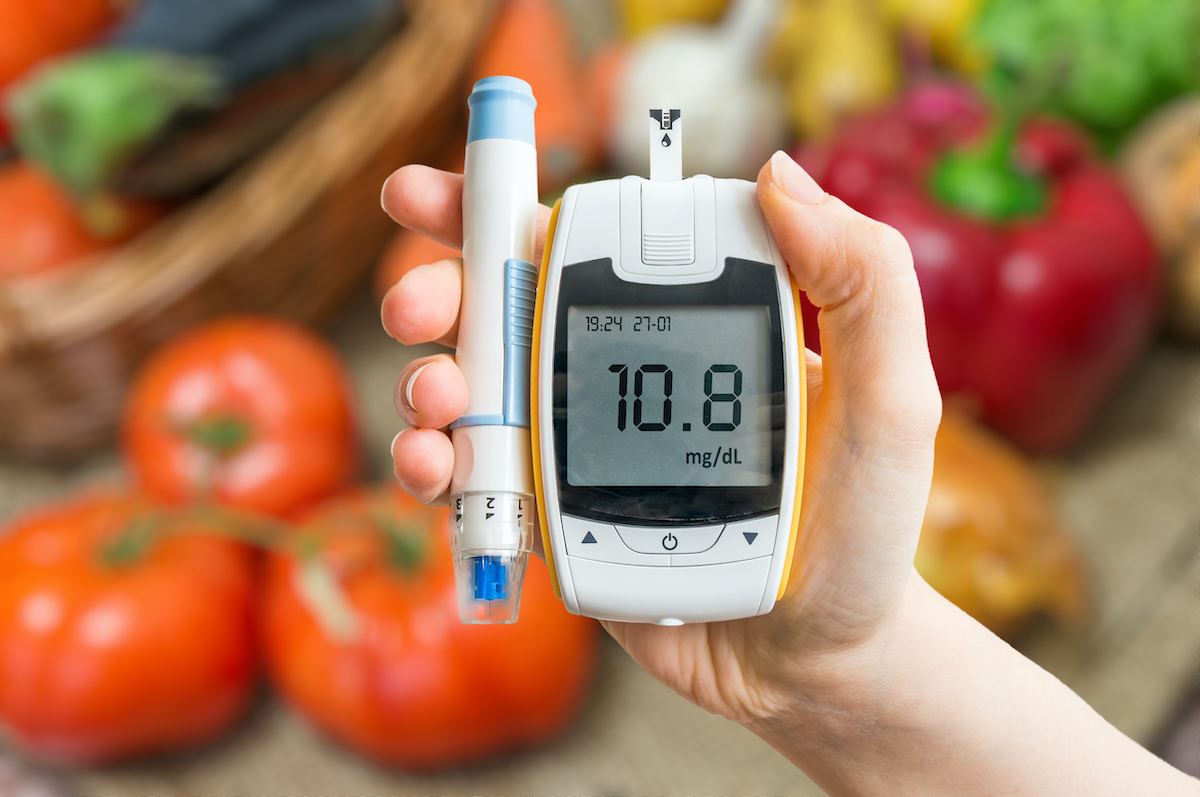What’s the Difference Between Blood Sugar vs. A1c?
Understanding blood sugar vs. A1c is key to managing diabetes. Here’s what each one does—and doesn’t—tell you.

Sometimes it feels like test results from your doctor’s office are written in code.
But when it comes to blood sugar and hemoglobin A1c, also known as HbA1c or just A1c, it’s a surprisingly simple one to crack.
Whether you’re living with diabetes, at risk of developing it, or caring for someone with the condition, here’s what you need to know about the difference between blood sugar and A1c, plus tips on how to keep both in a healthy range.
What Is Blood Sugar?
Measuring your blood sugar, also called blood glucose, is a way of knowing exactly how much glucose is in your bloodstream at any given moment, explains Renu Joshi, M.D., an endocrinology, diabetes, and metabolism specialist and the chief of endocrinology at UPMC Central Pa.
If you don’t have diabetes, your blood sugar is typically only measured during annual physical exams and if/when you’re admitted to the hospital for any reason. People living with diabetes, on the other hand, must regularly measure their own blood sugar. In fact, blood sugar monitoring is “the most important thing you can do to manage type 1 or type 2 diabetes,” according to the Centers for Disease Control and Prevention (CDC).
Why? Because it’s important for blood glucose to stay in a healthy range, and regularly measuring it allows you to see what makes your numbers go up or down, such as eating certain foods, exercise, stress, or taking medicine.
If your blood sugar gets too low (hypoglycemia), you might lose the ability to think clearly and function normally. If it gets too high (hyperglycemia) and stays high, it can lead to serious diabetes-related complications such as heart disease, eye problems, nerve damage, and kidney disease, Dr. Joshi says.
How Is Blood Sugar Measured?
Blood sugar is measured using a glucose meter. You prick your finger and apply a drop of blood to a test strip, which is then inserted into the electronic meter. After a few seconds, the reading will appear in milligrams of glucose per deciliter of blood, abbreviated as mg/dL.
Some people prefer continuous glucose monitors (CGMs), which use a tiny sensor inserted underneath your skin to constantly measure your blood sugar. When your levels are too high or too low, the CGM sends an alert to a monitor or an app on your phone.
How Often Should I Test My Blood Sugar?
The ideal frequency depends on the person, so your doctor will tell you when and how often to check your levels, says Vandana Sheth, R.D.N., a spokesperson for the Association of Diabetes Care & Education Specialists.
At minimum, she recommends that people with diabetes test their fasting blood sugar first thing in the morning (when you haven’t eaten for about eight hours) and doing another reading after your biggest meal of the day. People who take insulin—that is, everyone with type 1 diabetes and some people with type 2 diabetes—will likely need to test more often.
What’s a Healthy Blood Sugar Level?
The American Diabetes Association (ADA) recommends the following for most adults with diabetes who are not pregnant:
Before meals: 80 to 130 mg/dL
One to two hours after the start of a meal: Below 180 mg/dL
That said, factors like age, the medications you take, and whether you have type 1 or type 2 diabetes can affect your personal blood sugar goals, so it’s important to work with your doctor to identify the best targets for you.
What Is Hemoglobin A1c?
Hemoglobin A1c is an average of all your blood sugar levels over the past three months, measured with a simple blood test.
Since your blood sugar can change so much throughout the day—based on what you eat, how active you are, or your stress levels—a single reading done during an office visit isn’t that helpful for your primary care provider. They want to see the bigger picture of how your blood sugar levels are changing (or not) over time. That’s where an A1c test is helpful.
“Hemoglobin A1c is used to monitor how well you’re managing diabetes over time,” Dr. Joshi says. It can reveal if anything about your treatment plan might need to change, and it’s also commonly used to diagnose prediabetes and diabetes.
Consistently high blood sugar levels will raise your hemoglobin A1c, and consistently lower blood sugar levels will lower it. However, the two measures aren’t expressed in the same units, which can be confusing. While blood sugar is measured in milligrams per deciliter (mg/dL), hemoglobin A1c is given as a percentage.
Why a percentage? When sugar enters your bloodstream, it attaches to hemoglobin, the protein inside your red blood cells that carries oxygen from your lungs throughout your body. Everybody has some sugar attached to their hemoglobin, but people with higher blood sugar levels have more. The A1c test measures the percentage of your red blood cells that have sugar-coated hemoglobin.
What’s a Healthy Hemoglobin A1c?
For most people managing diabetes, the goal is to keep your hemoglobin A1c levels below 7 percent, Dr. Joshi says. “Your health care provider may have other recommendations for you, depending on your overall health, age, weight, and other factors.”
An A1c test used for diagnosing prediabetes or diabetes uses the following ADA guidelines:
Normal: Below 5.7 percent
Prediabetes: Between 5.7 and 6.4 percent
Diabetes: 6.5 percent or higher
How Often Do I Need a Hemoglobin A1c Test?
Because hemoglobin A1c measures average blood sugar over time, there’s no need to check it so regularly. That’s why home glucose meters don’t check it; it requires a trip to your doctor to have blood drawn.
Subscribe to our newsletter
It's quick and easy. You could be one of the 13 million people who are eligible.
Already a member? Click to discover our 15,000+ participating locations.
Follow Us
People with well-controlled diabetes typically get the hemoglobin A1c test twice per year, Dr. Joshi says, whereas people with poorly controlled diabetes might need the test every three months. It’s up to your provider to decide how often you need the test.
How Can I Keep Blood Sugar and A1c Levels in a Healthy Range?
While it’s helpful to know the difference between blood sugar and hemoglobin A1c, the strategies for keeping both within a healthy range are the same.
First and foremost, it’s important to work with your primary care provider to determine a healthy range for you, and to set targets for fasting blood sugar, post-meal blood sugar, and hemoglobin A1C. Beyond that, there are few things Sheth and Dr. Joshi recommend:
1. Stay on top of regular blood sugar checks. “Testing your blood glucose and keeping good track of your readings is essential for knowing how different activities, foods, medicine, and stress affect your blood glucose readings,” Dr. Joshi says.
Think of blood sugar readings as a tool to help you feel your best, Sheth adds. “If you don’t know what your blood sugar level is, you can’t make decisions that can help you avoid highs and lows in the future.”
2. Know that different strategies work for different people. There’s not one diet or set of lifestyle rules that works for everyone in managing blood sugar and hemoglobin A1c. Instead of getting bogged down in too many specifics, Sheth recommends eating regularly throughout the day, staying hydrated, and eating balanced meals that contain a mix of non-starchy vegetables (asparagus, beets, broccoli, cabbage), protein, carbs, and healthy fats (avocado, nuts, olive oil).
3. Fit in 10 to 15 minutes of movement after meals. This is especially helpful after big meals, as it can prevent your blood sugar from rising too high, Sheth says. Going for a walk or doing some light yardwork or other chores are good options.
4. Enlist professional help. If you’re having trouble keeping blood sugar in a healthy range or just want more guidance, a dietitian or a certified diabetes care and education specialist (who might be a dietitian but is often a nurse) can be a great resource. They can work with you “to create a customized action plan to keep you on track,” Sheth says.
Take Your Favorite SilverSneakers Classes Online!
SilverSneakers members can access live fitness classes and wellness workshops through SilverSneakers LIVE. See the latest schedule and RSVP for classes here.
Not a member? If you have a Medicare Plan, it may include SilverSneakers—at no additional cost. Check your eligibility instantly here.





